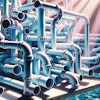
America the beautiful, America the automated," says Barry Brunye, vice president of Hayward's Goldline Controls division. "When was the last time anyone got out of their car to open the garage door? Or got off the couch to change the TV channel. Apple pie, American flag and automation." Brunye, a veteran of the electronics industry, deftly sketches the American consumer.
In addition to their desire for remote-control everything, some consumers and builders are learning about — and developing a taste for — the ever-expanding repertoire of today's microprocessor-powered controllers. But just as some people are still getting used to the idea of a wireless phone, some pool owners just want the remote control for their spa.
If history is any indication, most pool owners will eventually join the automation nation. As they start to use their controllers and become more comfortable with the technology, pool owners start to understand just how powerful the devices are. "When we started doing automation for pools," says Brunye, "we were focused on automation for the masses, so every pool could be automated with the 'keep it simple' principal. However, demand from the builders and the consumer applications, now its becoming more and more sophisticated, with capacity for more and more features and these unique applications: All of a sudden, there's more in the product than was originally envisioned."
The transition can be slow and uneven, though, with some consumers and builders racing ahead to adopt the latest innovations and others firmly entrenched with the entry-level model. So industry manufacturers are busy pushing the envelope on technology, creating evermore-sophisticated and capable devices. At the same time, they're continuing to provide the classic controllers that appeal to a sizeable segment of the pool-owning population, and coaxing them along on the high tech adventure.
It's In There
David McCallum brought high-tech expertise from Intel Corp. to Pentair Water Pool and Spa. He sees consumers embracing the pool control and automation market space. "Homeowners and consumers are increasingly aware. We're becoming a gadget society," says McCallum. "I think consumers are increasingly driving things. They say, 'Hey, Mr. Pool Builder, what about this.' Some people want to be able to control the temperature of the pool and spa from a wireless remote inside, and use it to check stock quotes and email and then go back and turn on the chlorinator."
If you haven't been paying attention to the speed of progress in the control and automation market, just consider your cell phone for a moment, and you'll get the idea of how fast technology is moving and how boundless the possibilities are.
"The cell phone started out as a simple phone," says Brunye. "Now, with something like a Blackberry, you have internet access, e-mail access, GPS, music downloads." And where you started with a simple pool controller, now there are units that monitor and adjust chemicals, control lighting programs, pumps, spas — all from the comfort of a handheld device that also checks your e-mail and allows you to surf the Internet.
While consumers who are early adopters (eager to try the latest innovations) certainly enjoy the latest technologies, they may also be a little device-weary.
"People would rather have one interface," says McCallum. "Everyday consumers are just bombarded by so many interfaces. Tivo, iPod, cell phone, Palm. It's just nice to have one interface for the entire property automation.
"The interfaces that the homeowners used were single-purpose devices," says McCallum. They were pool and spa controls and that was all they were ever going to be. It was great — it worked. But my goal was to bring industry-standard computing hardware to the mix. So I launched a series of advanced, high-tech interfaces that give customers a better user experience for controlling the pool and spa and their backyard. And it also allows them to browse the internet, check e-mail, so it does all these other things. It's not just a pool-spa control anymore, it's a multi-purpose computing device."
While tech-savvy early adopters text message "Hooray!" from their Blackberries when they learn about the automation options, not all consumers want so many choices.
"It depends on how savvy the homeowners are," says McCallum. "some just want one button to turn on the pump and they're happy." And for those customers, the older — or shall we say "classic" — models are just right. "[Older-generation Compool] is still a popular seller," says McCallum. "Pool builders make the technology move when they're comfortable and not before.
Goldline's Brunye says his company does a steady business, too, in the classic controllers. "We're selling tens of thousands a year that are just remotes," he says. "They go out and sit by the spa, they turn things off and on, they turn their heat up or down, the lights on or off, whatever they want through wireless technology. That's pretty standard. And the consumer loves it, frankly."
Rich Young of Aquatic Commercial Industries sees the range of consumer requests that builders should address. "Some people want to be able to consult their Blackberry and see the pH, chlorine, temperature in their pool in California before they take off from Heathrow," he says. "Some people just want basic controls so that when they go away for a long weekend and come back their spas aren't green."
With modern electronics, consumers often are unaware of the power they may have a their fingertips. "With faster and faster microprocessors and smaller chips it's constantly evolving, says Brunye. "Because of the capacity of the microprocessors, an application like pool automation is a fraction of what that the chip can do. So with a bunch of engineers thinking about all the possibilities, these things have become so sophisticated that the homeowners don't even know what they have. If you poll the consumer after purchase, pretty much it's on automatic, they don't go near them."
As the category matures, that's the beauty of the technology. Builders can sell the functions that meet their customers' comfort levels.
"At the time of the sale, you really don't want to confuse the pool owner too much about what they're getting," says Brunye. Savvy builders, however, know their customers and can gauge just how much technology the pool owner will be comfortable with.
"If, during the conversation, questions come up and the homeowner says, 'I travel a lot, I don't want my pool to turn green,' the builder can say, 'Your system actually generates its own chlorine.' When the customer says, 'I don't want to have to go out at night to turn the spa off and on.' No, you don't have to do that, you just push a button that's on the remote on the wall, or that's wireless and could be on the coffee table or out on the veranda. So you don't want to complicate the sale, because the consumer is only going to absorb so much, and if you get to an information overload, you might scare them away from a sale," says Brunye.
Behind The Scenes
For the residential consumer, the biggest attraction tends to be convenience and ease of use. If the automation is doing its job, the homeowner may not even know the extent of the miracles it's performing, but they are thoroughly pleased with the ability to remotely control lights, jets and water temperatures.
In the commercial setting and for the builder or service technician, cutting-edge control and automation can really handle much of the heavy lifting — the behind-the-scenes operations that ensure the homeowner has a spotless pool and crystal clear water.
"My recommendation is that we not call it automation anymore, because it's much more than automation," says Young. "I get away from that to call it micro-processor monitoring and control. It even goes beyond that because not only does it monitor and control, but it keeps a history of what it's doing. If there is a problem, it notifies you. Now you've got the whole gamut of monitoring, analyzing, control, history and notification. With today's telemetry, it can call your cell phone or a pager or send an e-mail notifying you of a problem before it becomes an issue."
For those managing multiple pools, the progress is on an order of magnitude. "This goes beyond just a single facility," says Young. "I know of one operator who has well over 100 pools on an Internet system. It's totally wireless. He can poll all his facilities and see if there are any problems. If there are, he can access that facility via the Internet find out what's wrong and possibly troubleshoot it without ever having to drive over there."
SpaConnect system is designed to save money and hours for service techs working on compatible hot tubs. The diagnostic tools allow Internet access to a hot tub's diagnostic data before a technician is even dispatched to the field. As Balboa's marketing materials put it, "All the right information, people and tools can instantly be in the right place, at the right time, focused on fixing equipment problems." The company is developing a similar system for pools.Trickling Down
As with any emerging technology, the barrier to entry for many consumers is price. That certainly was an issue in the past, but it's quickly fading. "With microprocessors, the price of controllers has come down tremendously. In the mid '80s, a control system — which was smart for that time but stupid by today's standards — cost around $6,000," says Young. "Even on commercial controllers now, rather than $5,000, a good, solid commercial control with UL listings and quite a few bells and whistles and 30-day history, you're looking at something installed for about $2,500. On a residence we're talking about something now that's more into the $1,500 range installed. So when swimming pools used to cost $25,000 to $30,000, well you're not going to spend $2,000 on controls. But now, I'd venture to say that 20 to 25 percent of pools being built today are well over $50,000, with a portion of those being well over $100,000. For many people it's nothing to them to spend $150,000 to $250,000 on a swimming pool. If they're going to spend that, what's another $3,000 to $4,000 for a top-ofthe-line control device to control their pumps and lights and maintain chlorine and pH and heat and security and everything else."
Easing Into It
In all areas of technology, whether it's cell phones, laptop computers or audio-visual equipment, consumers are reluctant to buy into a fast-changing market. They don't want to buy electronic equipment just to find out a few weeks later that a better and cheaper version is available. Some companies have bridged that gap with upgrades, or conversion kits, for existing equipment. For example, Jandy offers a conversion kit that gives homeowners a simple, up-to-date interface without having to retrofit the entire system.
What's next? More automation and more communication. Says Pentair's McCallum, "I see the merging of backyard and in-home control. I think the line between the two is going to merge as time goes on. Why have two when you can have one?"
Telephony and the Internet will play increasingly significant roles, too. Says Timothy Petsch of TMI SaltPure, "I think you'll find high-end spas in the future that will send an e-mail or page when they get into distress: 'Hi, my pH is too high.'"







































